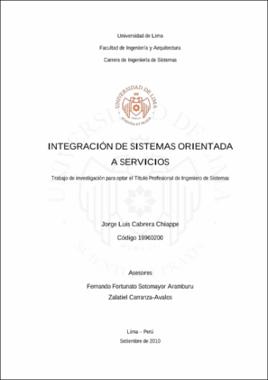| dc.contributor.advisor | Sotomayor Aramburu, Fernando Fortunato | |
| dc.contributor.advisor | Carranza Avalos, Zalatiel | |
| dc.contributor.author | Cabrera Chiappe, Jorge Luis | |
| dc.date.accessioned | 2022-04-20T16:36:33Z | |
| dc.date.available | 2022-04-20T16:36:33Z | |
| dc.date.issued | 2010 | |
| dc.identifier.citation | Cabrera Chiappe, J. L. (2010) Integración de sistemas orientada a servicios [Trabajo de investigación para optar el Título Profesional de Ingeniero de Sistemas, Universidad de Lima]. Repositorio Institucional de la Universidad deLima. https://hdl.handle.net/20.500.12724/15587 | es_PE |
| dc.identifier.uri | https://hdl.handle.net/20.500.12724/15587 | |
| dc.description.abstract | La integración de sistemas y el despliegue de arquitecturas de Integración Empresarial EIA (Enterprise Integration Arquitecture - Arquitectura de Integración Empresarial) constituyen, actualmente, algunas de las tareas más demandantes en la industria de tecnologías de información. En la medida de que las empresas poseen aplicaciones desarrolladas en diversas tecnologías, entre ellas, Sistemas de Planeación de Recursos Empresariales ERP (Enterprise Resource Planning), correo electrónico (email), sistemas de Planeamiento de la Producción, sistemas de Gestión de Ventas e Inventarios, Sistemas de Recursos Humanos, Gestión de clientes (Customer Relationship Management), las cuales requieren ser integradas. Dentro de este contexto, SOI (Service Oriented Integration o Integración de Sistemas Orientada a Servicios) propone dicha integración entre soluciones computacionales utilizando interfaces basadas en servicios con interfaces y servicios estandarizados. La presente investigación demuestra que la integración SOI permite:
1. Aumentar la eficiencia en el desarrollo y mantenimiento de interfaces.
2. Reducir del esfuerzo en el proceso de desarrollo y mantenimiento de interfaces entre sistemas.
3. Unificar y estandarizar las interfaces hacia el uso de Servicios Web (Web Services) y XML (Extensible Markup Language), en los casos donde sea aplicable.
4. Mejorar la interoperabilidad de las distintas plataformas en la empresa.
5. Aumentar la reutilización de interfaces y componentes desarrollados.
6. Facilitar la integración con distintas entidades de negocio (por ejemplo: proveedores y clientes), mediante un estándar de facto (Web Services). | es_PE |
| dc.description.abstract | System integration and the EIA (Enterprise Integration Architecture) discipline conform nowadays one of the most demanding in the IT industry. This respond to the fact that organizations own already implemented applications, develop in many different technologies like ERP, emails, Production Planning, Inventory, Sales, Human Resources, CRM, etc.; Those require to be integrated. Is into this context that SOI (Service Oriented Integration) proposes the integration between those computational entities use interfaces based in standardized services. The present work investigates and probes that the following benefits are achievable following SOI:
1. Improve the efficiencies in the interface development.
2. Reduction of the effort for the develop and maintenance of the interfaces.
3. Unification and standardization in favor of Web Services (Web Services) y XML (Extensible Markup Language), where applicable.
4. Improve the interoperability of the organization applications.
5. Increase the re-use of interfaces and related.
6. Facilitate the integration with other entities like providers, customers and financial services throw this standard. | en_EN |
| dc.format | application/pdf | |
| dc.language.iso | spa | |
| dc.publisher | Universidad de Lima | |
| dc.rights | info:eu-repo/semantics/openAccess | * |
| dc.rights.uri | https://creativecommons.org/licenses/by-nc-sa/4.0/ | * |
| dc.source | Repositorio Institucional - Ulima | es_PE |
| dc.source | Universidad de Lima | es_PE |
| dc.subject | Arquitectura orientada a servicios (Ciencias de la computación) | es_PE |
| dc.subject | Service-oriented architecture (Computer science) | es_PE |
| dc.title | Integración de sistemas orientada a servicios | es_PE |
| dc.title.alternative | Service oriented system integration | en_EN |
| dc.type | info:eu-repo/semantics/bachelorThesis | |
| thesis.degree.level | Título Profesional | es_PE |
| thesis.degree.discipline | Ingeniería de sistemas | es_PE |
| thesis.degree.grantor | Universidad de Lima. Facultad de Ingeniería y Arquitectura | es_PE |
| dc.publisher.country | PE | |
| dc.type.other | Trabajo de investigación | |
| thesis.degree.name | Ingeniero de sistemas | es_PE |
| renati.discipline | 612076 | |
| renati.author.dni | 10809221 | |
| renati.level | https://purl.org/pe-repo/renati/level#tituloProfesional | * |
| renati.juror | Soto Soto, Luis | |
| renati.juror | Sánchez Tenorio, Juana Viviana | |
| renati.juror | Sotomayor Aramburú, Fernando Fortunato | |
| renati.type | https://purl.org/pe-repo/renati/type#trabajoDeInvestigacion | * |
| dc.subject.ocde | https://purl.org/pe-repo/ocde/ford#2.02.13 | |
| ulima.cat | OI | |



